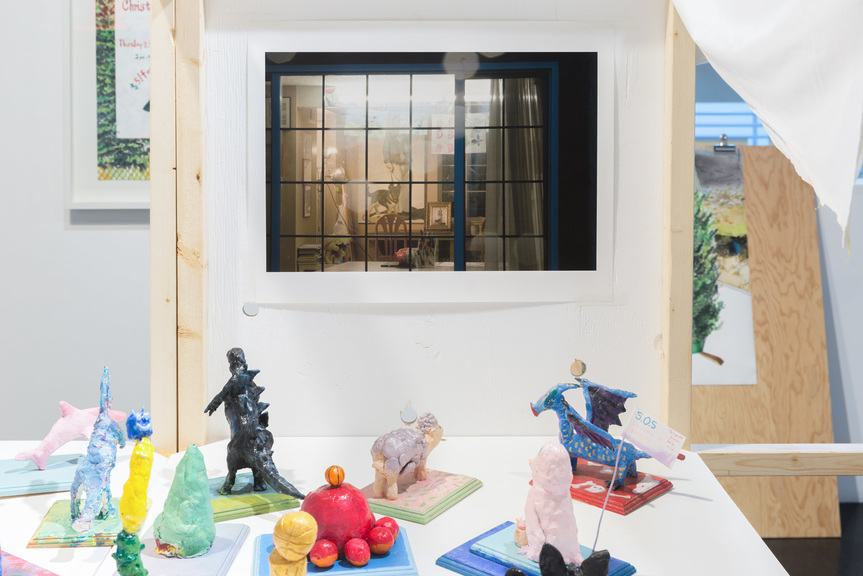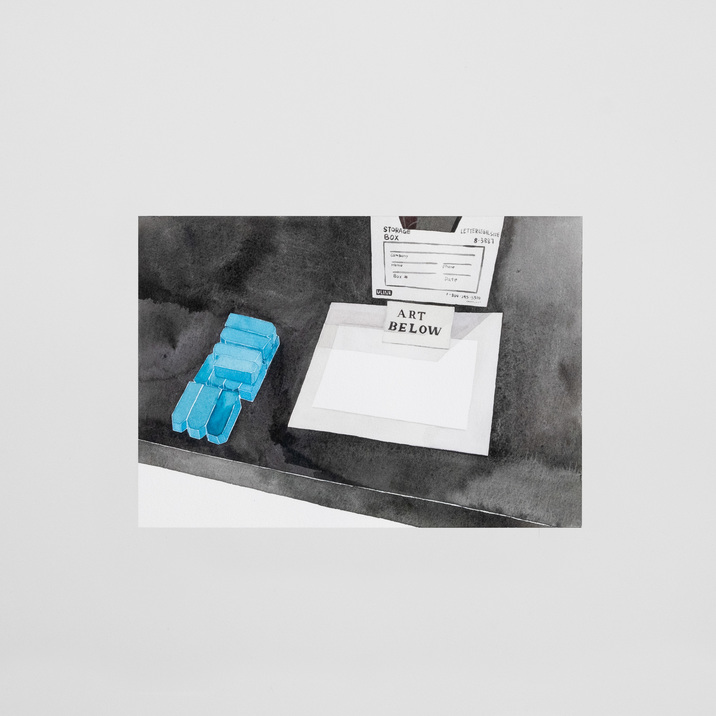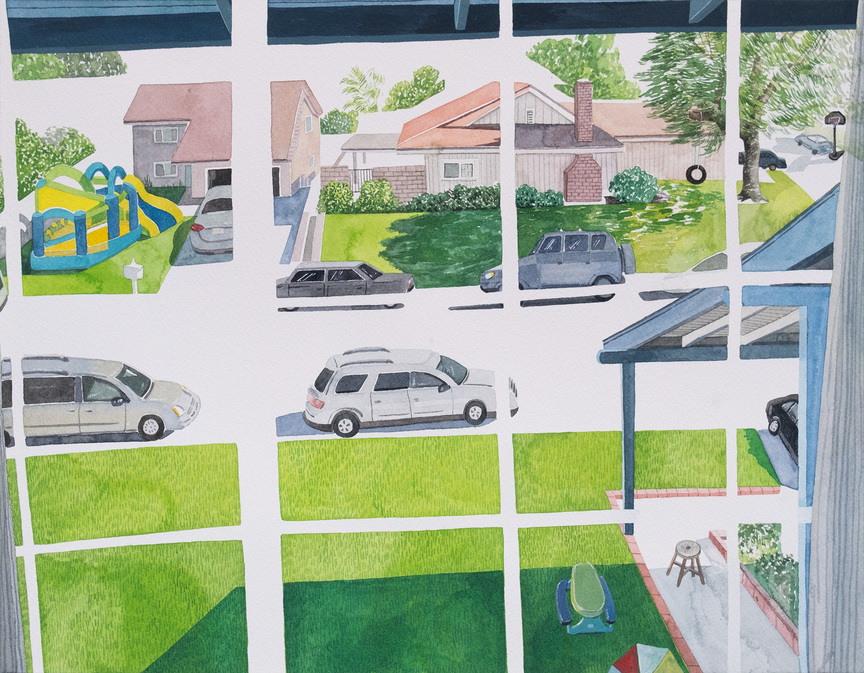
R
E
V N
E
X
T
As an artist and art educator, John Ziqiang Wu finds himself at the nexus of two industries severely impacted by the pandemic. He and his wife, Yinan, co-founded and run an art-tutoring workshop in Chino, east of Los Angeles, while John continues his practice that revolves around different conceptions of art found in society. For the June Art Fair, which is being hosted online during August 20–31 by Hauser & Wirth on its website, Empty Gallery is presenting ten of Wu’s recent watercolor paintings from a 2019–20 residency at the Hammer Museum as well as the early months of the pandemic. ArtAsiaPacific caught up with Wu on the phone last week to talk about his interest in teaching art and in learning other people’s stories.
What’s life in Los Angeles like at the moment?
Covid-19 is out of control, so we’re all at home. We’ve been at home for five months already. We sometimes go out to the park or go hiking. My son just started school online. We’re looking at screens a lot.
We run a studio to teach art to kids and sometimes adults. It’s called the Learning Art and Art Learning Studio. I’m still teaching a little on Zoom but 70 percent of our students are not taking online classes so I only have three classes. The studio is also my house and I use the studio to make my art. It’s multifunctional.
I’ve been teaching art for a long time, more than ten years, and we started the studio in 2015. It’s very beneficial as much of my art practice relates to teaching. There are a lot of pedagogical elements in my work.
What is your approach to teaching art?
It’s really interesting to teach children. All kinds of audiences have different expectations for art—from parents, grandparents, and kids. And when I was in art school, I learned a different kind of art. My perspective also comes from my personal background. I’m from Tangshan, China. I had a traditional European kind of art training, under the “academy art” system. As a high-schooler you have to learn sketching and painting, and then to get into university there is an exam. There is the traditional value of “mastering the masters.” Copying is a method of learning art to a lot of art learners in China. But I didn’t finish university [at Tianjin Academy of Fine Art]; I moved here. I had to quickly adjust, I struggled to go from realistic to abstract, conceptual, and other types of art.
My personal background, and also my teaching, mirror how I see different kinds of art existing in society and the different expectations for art. My teaching job reminds me of this all the time, which is why my art relates how to approach different audiences and how to approach art in different ways.
How did those interests inform your 2020 exhibition “Art Making” at the Armory Center for the Arts in Pasadena?
“Art Making” related to our school’s name, Learning Art and Art Learning Studio. For me “learning art” relates to everyone no matter what level you are; it’s a universal thing. But then “art learning” becomes a discipline, then you get into an art-learning institution where there’s a different way of teaching art and defining art. Art enters into the institutional value system and becomes high art, low art, amateur art. The Armory was the perfect place for me because it has an exhibition space and learning area.
The show had a lot of different kinds of work, from my own journey with art from different periods and also my pedagogy, including my students’ works. At the end of the galley space there was an interactive station where audiences could draw something and then post it. So as an exhibition, “Art Making” contained very different kinds of art-making spaces. People with different kinds of background or understanding all found a way to engage with the show.
What did you do during your residency at the Hammer Museum?
I proposed a one-year project. The Hammer has a lot of departments and I wanted to do a one-day internship in every department. I thought I could learn a lot from the museum. If I spend a lot of time with the people in a specific place, I can make a lot of work from these experiences. The drawings are based on the observations I had while there and other inside stories.
The drawing Art Below is like that. I was in the drawing conservation department working with Mo [McGee], a conservator. She prepared three Japanese ink prints on a sheet of paper and then placed white paper on top, with a sign saying “Art Below” as a warning. There is a kind of irony in making that into a painting. If you don’t know the actual story maybe you’ll think “Art Below” is some kind of mystery. I found it funny to read the words from different perspectives. Conceptual art often plays with words or titles.
How did you choose the moments to represent in paintings?
I take a lot of photographs. They become like a memories and then I can do a little bit of articulation in the drawing. I also draw from observation—I try to remember a scene or draw a thumbnail in my sketchbook. It relates to the value of creating something new. A lot of my work, like The Lamps’ Story, is based on the idea that if you spend time or pay more attention to the things around you, it turns out that you didn’t really know them.
Were you trying to create a portrait of the museum through these observations?
My perspective is based more on the people rather than the work in the museum, or the museum as an institution. The curatorial department understands art, and the facilities department might understand and engage with it in a different way but somehow they all work together to make the museum function.
The book, which has about 70 drawings, is called One Day Intern, and is subtitled “The Value of Learning Something New.” I learned a lot from the different department visits, and maybe they learned something from me, or we learned something together through sharing our stories. It’s rare for an artist to spend the day with them. Some people may have thought dealing with an artist was additional work on top of their busy day. Some people liked to ask more questions and to know a bit about me. I’m sure it felt kind of odd for them too. And when there’s something odd or out of the routine, I think there’s a chance to be more creative. So the “value of learning something new” is not just for me but for them too if they learn to reach out and interconnect with different departments and with people of many different backgrounds.
Is that your main way of approaching art—as a way of telling stories?
I also have other kinds of art practice, like my studio painting practice, which is a kind of painting development from my journey of learning and teaching art. But I like to make stories—people are moved by good stories. I feel that stories have more value and will be held onto for longer. At end of the day, the memory of stories is the only thing that remains.
This interview has been edited for length and clarity.
HG Masters is the deputy editor and deputy publisher of ArtAsiaPacific.
The June Art Fair is online until August 31, 2020.
To read more of ArtAsiaPacific’s articles, visit our Digital Library.

















